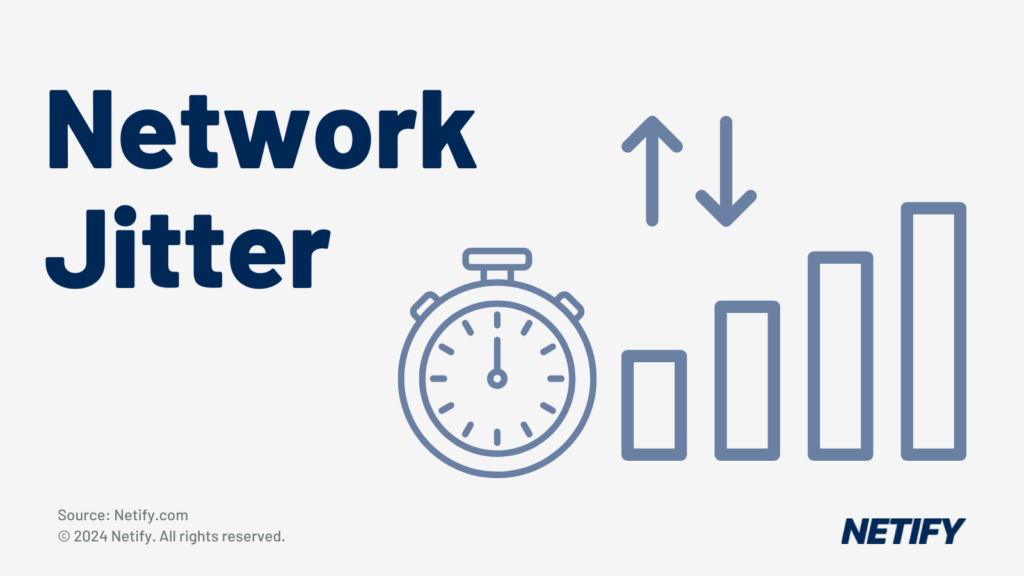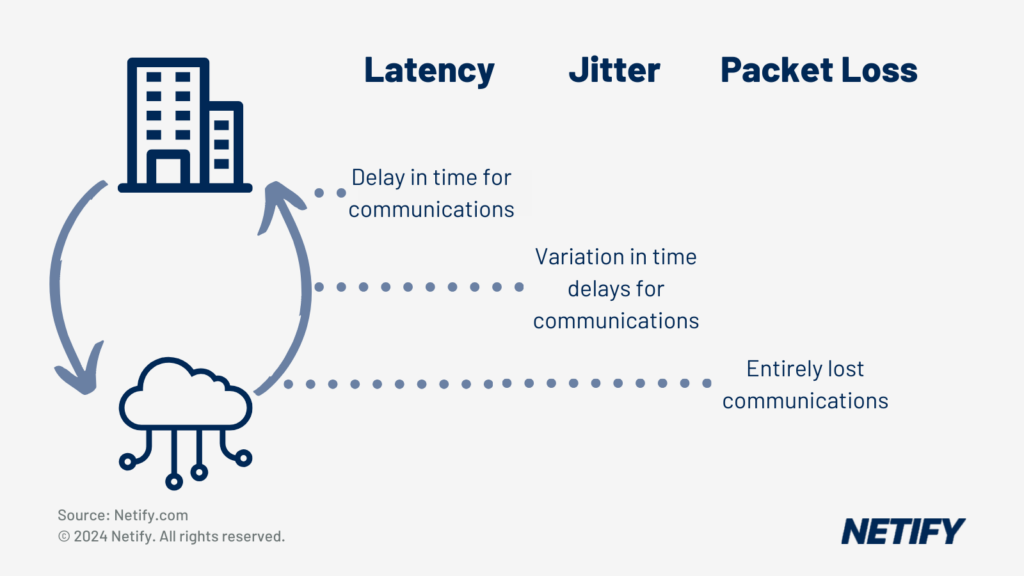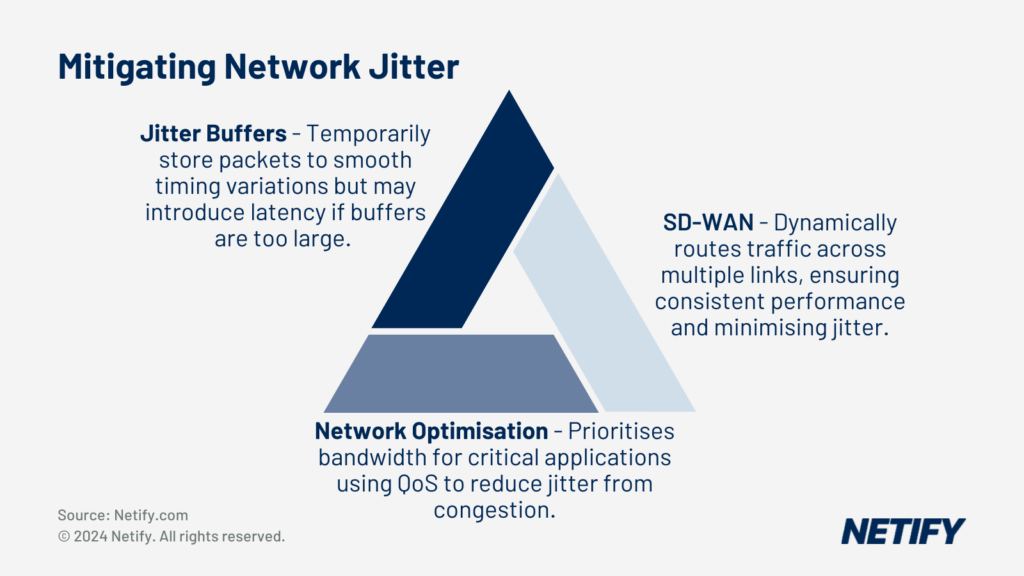What is Network Jitter?
| Network jitter is the variation in time between packets. When inconsistent, streams of data become interrupted and cause issues with networked processes. |
Jitter refers to the variation in the flow rate of packet arrival times. Unlike latency, which refers to the overall delay of all packets, jitter refers to inconsistencies in delays between packets. Due to the rate of delay changing, jitter can introduce potential disruptions to business-critical real-time applications, such as Voice-over-Internet-Protocol (VoIP) and video conferencing.

However, mitigating jitter can be problematic due to the range of causes.
Network Congestion
Networks that experience high traffic volumes are typically prone to jitter, especially where bandwidth limits apply or where bandwidth demand outweighs bandwidth supply. This means that during peak use, network bandwidth capacities can be overwhelmed, causing delays (latency) or uneven packet delivery (jitter).
Routing Problems
Another cause of jitter is inefficient routing, where networks are misconfigured to use poor performing paths, leading to packets experiencing delays. Similarly, these effects can be experienced due to improper queuing of packets, where data transmissions are received out of order and frequent route changes, where constant switching to higher performing routes introduces so much delay that it defeats the point in switching to begin with.
Wireless Interference
Whilst congestion and routing issues are typically software related, one hardware reason for jitter is wireless interference. This occurs when physical objects cause signal interferences, such as electromagnetic noise, leading to an affected arrival time. Jitter caused by interference is typically seen in environments containing competing wireless signals, where each wireless signal interrupts each other.
Types of Jitter
With many causes comes many types of jitter, which are each classed based on their specific characteristics.
Random Jitter
The first of these types in random jitter, which has the typical characteristics of unpredictable variations in packet arrival times. This form of jitter stems from random network noise or irregular processing delays that are not accounted for as part of packet timing systems.
Deterministic Jitter
Unlike random jitter, deterministic jitter is consistent variation in packet arrival timings. This means that typical jitter can be predicted, with specific data patterns or regular network activity being the cause for the jitter.
Impact on Real-Time Applications
Jitter can have severe impacts for real-time applications, which businesses need to consider how their day-to-day critical operations can be affected.

VoIP and Audio
One of the most common business application types, Voice-over-Internet-Protocol (VoIP) is particularly vulnerable to the effects of jitter. For these applications, jitter can lead to complete packet loss, causing choppy audio, call delays and even dropped calls. Given how common VoIP can be for businesses, eliminating jitter is crucial for ensuring day-to-day operations run smoothly.
Video Conferencing
Another common application that can be affected by jitter is video conferencing. These applications experience synchronisation issues, with frame freezing, misaligned audio and video, as well as resolution drops. Eliminating jitter for video conferencing is especially important for remote workers and virtual meetings, as this can commonly be businesses main form of communications.
Financial Trading Systems
A more specific case of where jitter can be detrimental to business operations is within financial trading systems. These systems rely on high frequency trading and minor jitter delays to data delivery can have massive impacts on trading times. In an industry where milliseconds count, this leads to missed opportunities and potentially significant losses. Reliable, low-latency communications, with minimised jitter is essential for making sure crucial trades are executed at the right time with no delay.
Measuring Jitter
Given the effects on different application types, businesses should look to manage the levels of jitter experienced. The best way this can be achieved is by measuring and quantifying the impact of jitter on operations in order to determine the best solution.
Jitter Metrics
There are three main metrics for businesses to measure, jitter, maximum jitter and peak to peak jitter. These metrics show the severity and frequency of any jitter experience, assisting network administrators with assessing the impact on specific applications.
Acceptable Levels
The acceptable level of jitter can vary greatly based on the application being affected. For example, VoIP typically starts to degrade in quality after a 30ms jitter, with less than 30ms jitter being considered good for clear communications. For more timing-intensive use cases, such as financial trading, systems require much less jitter and therefore businesses should identify the acceptable jitter level for their critical applications.
Mitigating Jitter
Due to the varying types and acceptable levels of jitter, there are several strategies that businesses can adopt in order to mitigate it.

Jitter Buffers
Jitter buffers can be utilised to temporarily store packets in a buffer, allowing for smoothing of packet timing variations where a packet is delayed or missed. This can reduce the impact of short-term jitter on real-time applications like VoIP and video streaming. Unfortunately, this is often seen as a short term fix as introducing a larger buffer can introduce latency, whilst shorter buffers reduce the amount of jitter the buffer can compensate for.
Network Optimisation
One of the more effective ways to manage jitter is to optimise network operations through bandwidth allocations or Quality of Service (QoS). By assigning priority of bandwidth, businesses can minimise congestion and, in turn, reduce jitter for critical applications. This is particularly beneficial for networks with high data traffic, where critical applications would experience jitter due to less important applications using all the bandwidth.
SD-WAN
Arguably the best way that businesses can manage their jitter is through Software-Defined Wide Area Network (SD-WAN) solutions. This is due to the dynamic routing capabilities of SD-WAN, alongside the ability to leverage multi-path selection. This means that SD-WAN can simultaneously route traffic over MPLS, broadband and cellular network links, switching traffic to the best performing links. Real-time monitoring helps to analyse network conditions, with built in QoS and this provides value for businesses with multiple locations as it ensures consistent performance across branches.
Emerging Technologies to Prevent Jitter
There are many emerging technologies that are expected to help with jitter.
5G
One of these emerging technologies is 5G, which reduces the jitter in wireless communications. This is due to 5G not only having lower latency, but also more consistent transmissions than 4G and other previous generations of cellular connections. This is especially beneficial to businesses operating in mobile or remote environments and for those already utilising SD-WAN, 5G integrates easily as one of the usable path types.
AI Network Management
The rise in Artificial Intelligence (AI) and Machine Learning (ML) has enabled jitter to be mitigated by predicting jitter before it can occur and adjusting network parameters in real-time. This can be seen in many SD-WAN solutions, where SD-WAN utilises AI to analyse network traffic patterns and re-allocate bandwidth when jitter is anticipated.
Conclusion
By understand the types and causes of jitter, businesses can put measures in place to prevent and manage potential disruptions to critical services. For many businesses, SD-WAN is the best solution given its ability to best route traffic over dynamically assigned bandwidth, alongside many other benefits that SD-WAN has to offer networks.